Victorian dress reform
Victorian dress reform was an objective of the Victorian dress reform movement (also known as the rational dress movement) of the middle and late Victorian era, led by various reformers who proposed, designed, and wore clothing considered more practical and comfortable than the fashions of the time.
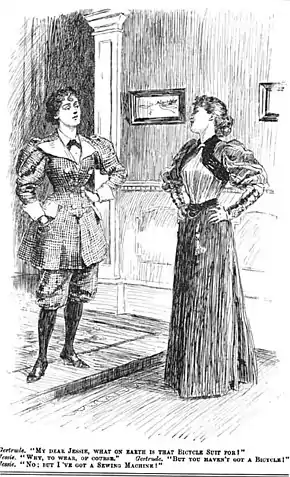
Jessie: "Why, to wear, of course."
Gertrude: "But you haven't got a Bicycle!"
Jessie: "No: but I've got a Sewing Machine!"
Dress reformists were largely middle class women involved in the first wave of feminism in the Western World, from the 1850s through the 1890s. The movement emerged in the Progressive Era along with calls for temperance, women's education, suffrage and moral purity. Dress reform called for emancipation from the "dictates of fashion", expressed a desire to “cover the limbs as well as the torso adequately,” and promoted "rational dress".[1] The movement had its greatest success in the reform of women's undergarments, which could be modified without exposing the wearer to social ridicule. Dress reformers were also influential in persuading women to adopt simplified garments for athletic activities such as bicycling or swimming. The movement was much less concerned with men's clothing, although it initiated the widespread adoption of knitted wool union suits or long johns.
Some proponents of the movement established dress reform parlors, or storefronts, where women could buy sewing patterns for the garments, or buy them directly.[2][3]
Criticisms of tightlacing
Fashion in the 1850s through the 1880s accented large crinolines, cumbersome bustles and padded busts with tiny waists laced into ‘steam-moulded corsetry’.[4] ‘Tight-lacing’ became part of the corset controversy: dress reformists claimed that the corset was prompted by vanity and foolishness, and harmful to health. The reported health risks included damaged and rearranged internal organs, compromised fertility; weakness and general depletion of health. Those who were pro-corset argued that it was required for stylish dress and had its own unique pleasures.[5] Eventually, the reformers' critique of the corset joined a throng of voices clamoring against tightlacing, which became gradually more common and extreme as the 19th century progressed. Preachers inveighed against tightlacing, doctors counseled patients against it and journalists wrote articles condemning the vanity and frivolity of women who would sacrifice their health for the sake of fashion. Whereas for many corseting was accepted as necessary for beauty, health, and an upright military-style posture, dress reformists viewed tightlacing as vain and, especially at the height of the era of Victorian morality, a sign of moral indecency.
American women active in the anti-slavery and temperance movements, having experience in public speaking and political agitation, demanded sensible clothing that would not restrict their movement.[6] While support for fashionable dress contested that corsets maintained an upright, ‘good figure’, as a necessary physical structure for moral and well-ordered society, these dress reformists contested that women’s fashions were not only physically detrimental, but “the results of male conspiracy to make women subservient by cultivating them in slave psychology.”[4][7] They believed a change in fashions could change the whole position of women, allowing for greater social mobility, independence from men and marriage, the ability to work for wages, as well as physical movement and comfort.[8]
_(cropped).jpg.webp)
Despite these protests, little changed in restrictive fashion and undergarments by 1900. The Edwardian Era featured a decadence of fashion following the ideal shape of the Gibson Girl, a corseted, big-bosomed ideal of femininity and sophistication.[9] Corset styles had altered slightly from the shorter-waisted, bustled 1880s vogue, but they still constricted the waist, forced the hips back with a pointed front waistline, thrust the bosom forward and curved the back into an exaggerated ‘S’ shape. Skirts weighed from the hips, high collars chafed the neck, and the whole costume prevented natural movement, harmed internal organs and threatened childbearing potential.[4] Invariably, the ideal image of feminine attractiveness that a Victorian woman saw around her (in fashion plates, advertisements, etc.) was of a wasp-waisted, firmly-corseted lady.
In the 19th century, poor women were known to wear corsets "boned" with rope, rather than steel or bone, to facilitate work in the field.
"Emancipation waists" and undergarment reform
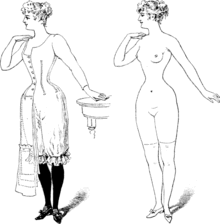
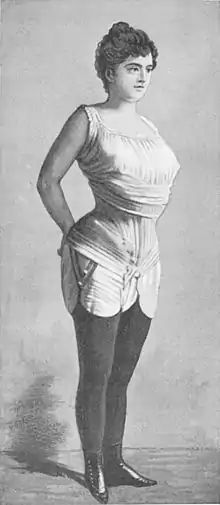

Dress reformers promoted the emancipation waist, or liberty bodice, as a replacement for the corset. The emancipation bodice was a tight sleeveless vest, buttoning up the front, with rows of buttons along the bottom to which could be attached petticoats and a skirt. The entire torso would support the weight of the petticoats and skirt, not just the waist (since the undesirability of hanging the entire weight of full skirts and petticoats from a constricted waist—rather than hanging the garments from the shoulders—was another point often discussed by dress reformers).[10] The bodices had to be fitted by a dressmaker; patterns could be ordered through the mail. Physician Alice Bunker Stockham railed against the corset and said of the pregnancy corset, "The Best pregnancy corset is no corset at all."[11] The "emancipation union under flannel" was first sold in America in 1868. It combined a waist (shirt) and drawers (leggings) in the form we now know as the union suit. While first designed for women, the union suit was also adopted by men. Indeed, it is still sold and worn today, by both men and women, as winter underclothing
In 1878, a German professor named Gustav Jaeger published a book claiming that only clothing made of animal hair, such as wool, promoted health. A British accountant named Lewis Tomalin translated the book, then opened a shop selling Dr Jaeger's Sanitary Woollen System, including knitted wool union suits. These were soon called "Jaegers"; they were widely popular.
It is not clear how many women, in either the Americas or on the Continent, wore these so-called "reform" bodices. However, contemporary portrait photography, fashion literature, and surviving examples of the undergarments themselves, all suggest that the corset was almost universal as daily wear by women and young ladies (and numerous fashionable men) throughout much of the 19th and early 20th centuries.
Bloomer suit
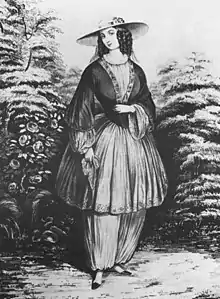
The most famous product of the dress reform era is the bloomer suit. In 1851, a New England temperance activist named Elizabeth Smith Miller (Libby Miller) adopted what she considered a more rational costume: loose trousers gathered at the ankles, like the trousers worn by Middle Eastern and Central Asian women, topped by a short dress or skirt and vest (waistcoat). She displayed her new clothing to temperance activist and suffragist Elizabeth Cady Stanton, who found it sensible and becoming, and adopted it immediately. In this garb, she visited yet another activist, Amelia Bloomer, the editor of the temperance magazine The Lily. Bloomer not only wore the costume, she promoted it enthusiastically in her magazine. More women wore the fashion and were promptly dubbed "Bloomers". A dress reform was supported by a campaign of the National Dress Reform Association, which was founded in 1856.[12]
They put up a fight for a few years, but were subjected to ridicule in the press[13][14] and harassment on the street.[15] The more conservative of society protested that women had ‘lost the mystery and attractiveness as they discarded their flowing robes.”[16]
Amelia Bloomer herself dropped the fashion in 1859, saying that a new invention, the crinoline, was a sufficient reform and that she could return to conventional dress. The bloomer costume died—temporarily. It was to return much later (in a different form), as a women's athletic costume in the 1890s and early 1900s.
Aesthetic Dress movement
In the 1870s, a largely English movement led by Mary Eliza Haweis sought dress reform to enhance and celebrate the natural shape of the body, preferring the looser lines of the medieval and renaissance eras. A historic nostalgia for more forgiving fashions, the aesthetic dress movement critiqued fashionable dress for its immovable shapes, and sought the ‘fashioning and adorning of a robe’ as tastefully complementary to the natural body.[17]
The Pre-Raphaelite Brotherhood and other artistic reformers objected to the elaborately trimmed confections of Victorian fashion with their unnatural silhouette based on a rigid corset and hoops as both ugly and dishonest. Some women associated with the movement adopted a revival style based on romanticised medieval influences such as puffed juliette sleeves and trailing skirts. These styles were made in the soft colors of vegetable dyes, ornamented with hand embroidery in the art needlework style, featured silks, oriental designs, muted colors, natural and frizzed hair and lacked definitive waist emphasis.[18]
The style spread as an "anti-fashion" called Artistic dress in the 1860s in literary and artistic circles, died back in the 1870s, and reemerged as Aesthetic dress in the 1880s, where two of the main proponents were the writer Oscar Wilde and his wife Constance, both of whom gave lectures on the subject. In 1881 The Rational Dress Society was founded in London. The Society advocated divided skirts as a more practical form of clothing, but its President and co-founder, Lady Florence Harberton, went further - when cycling, she wore full ‘Rational’ dress, which was a shorter skirt worn over voluminous trousers.
The rational dress movement by country
The dress reform movement spread from the United States and Great Britain to the Nordic countries in the 1880s and from Germany to Austria and the Netherlands. The issue was internationally addressed at the International Congress for Women's Work and Women's Endeavors in Berlin 1896, in which Germany, America, Belgium, Denmark, England, Finland, Russia, Sweden, Switzerland and Hungary participated.[19]
Denmark
In Denmark, the bloomer costume was adopted for girl's sports wear during ice skating already in the 1860s. While there were no separate dress reform societies founded in Denmark, the women's rights society Dansk Kvindesamfund actively addressed the issue under the influence of the Swedish Dress Reform Society in the 1880s; they published their own brochure, Om Sundheden og Kyindedraegten by J. Frisch, collaborated with Stockholm and Oslo with the design of reform costumes and the exposition of them, notably during the Nordic Exhibition of 1888.[20]
Finland
While there were no separate dress reform societies founded in Finland, the women's rights society Suomen Naisyhdistys actively addressed the issue under the influence of the Swedish Dress Reform Society in the 1880s; they held lectures in many Finnish cities, managed to have the reform costume accepted as sports wear in the girl's schools of the capital by 1887, and was awarded the grand silver medal for their reform costume for school girls in the exhibition of the Russian Hygienic Society in Saint Petersburg in 1893.[20]
France
There were no separate dress reform societies founded in France. While the issue was adopted and discussed by several of the excisting French women's rights organisations, the issue was not given priority and it was not until the great enthusiasm for bicycling in France in the 1890s that women in general adopted the bloomer costume with throuses and no corsets as sports wear.[19]
In the early 20th-century, however, the French fashion industry was finally influenced by the reform dress movement, which abolished the corset by the 1910s.
Germany
Germany was a leading country of the dress reform in the 19th-century, as it was an integrated part of the great health reform movement Lebensreform, which spoke for a health reform in clothing for both women and men supported by medical professionals and scientists such as Gustav Jaeger and Heinrich Lahmann, and freedom from the corset and throusers for women was advocated for already.[19]
The women's movement, however, did not engage in the issue until after the International Congress for Women's Work and Women's Endeavors in Berlin 1896, and the following year the German dress reform society, Allgemeine Verein für Verbesserung der Frauenkleidung, was founded. As their equivalents in Austria, the Netherlands and the Nordic countries, the German dress reform society, focused on a reform of women's underwear as the most realistic goal, mainly focused on the use of corsets. The German movement managed to affect public opinion to such a degree that one of its leading figures, Minna Cauer, was able to report in 1907 that the German corset industry experienced hardships because of a sinking use of corsets.[19]
The Netherlands
In the Netherlands, interest for the issue was aroused after the foundation of a dress reform society in neighboring Germany, and in 1899 the Dutch dress reform society Veereeniging voor Verbetering van Vrouwenkleeding (V.v.V.v.V.).[19] The dress reform society held lectures, participated in exhibitions and worked with designed to produce a new fashion for women which could be not only attractive but also comfortable and healthy at the same time.[19]
Norway
While there were no separate dress reform societies founded in Norway, the women's rights society Norsk Kvinnesaksforening actively addressed the issue under the influence of the Swedish Dress Reform Society from the 1880s; they collaborated with Stockholm and Copenhagen with the design of reform costumes and the exposition of them, notably during the Nordic Exhibition of 1888.[20]
Norway is in fact described as one of the countries were the interest and success for the issue was greatest. The physician Lorentz Dietrichson, a prominent participant for the abolition of the corset in the corset controversy in both Sweden and Norway, held a lecture in Norway in favor of dress reform already in 1886, as a commentary of the Swedish dress reform movement in which he himself also participated; the Swedish dress reform society successfully exhibited their reform dress in Oslo, the Norsk Kvinnesaksforening became interested, and the movement thereby started in Norway the same year as in Sweden. Johanne Biörn held lectures in the Oslo schools, and the Norwegian designer Kristine Dahl experienced success not only in her home country of Norway but also in Sweden, becoming a central figure of the dress reform movement.[20]
Sweden
Sweden was a leading nation of the dress reform movement, as the movement came first to Sweden of all the Nordic countries and spread from there to Denmark, Finland and Norway.[20]
In 1885, professor Curt Wallis brought with him the English language dress reform book Dress and Health from abroad, which was translated to Swedish by Oscara von Sydow as Reformdrägten: En bok för qvinnor skrifven af qvinnor.[20] After a speech by Anne Charlotte Leffler held at the women's club Nya Idun, the Friends of Handicraft gave Hanna Winge the assignment to design a reform costume, which was produced by Augusta Lundin and exhibited in public, which gave further publicity to the issue, and in 1886, the Swedish Dress Reform Society was founded.[21]
After an initial attempt to launch a reform costume, the Swedish dress reform movement focused on a reform of women's underwear, particularly the corset. The Swedish reform dress movement corresponded with their equivalent in Great Britain as well as the American dress reform movement of Annie Jenness Miller.[19]
The dress reform movement did achieve some success in Sweden; by the 1890s, corsets were no longer accepted for the pupils of the Swedish girls' schools, and the leading Swedish fashion designer Augusta Lundin reported that her clients no longer subjected themselves to tight lacing.[20]
Eventual shifts in fashion
Although the Victorian dress reform movement itself failed to enact widespread change in women’s fashion, social, political and cultural shifts into the 1920s brought forth an organic relaxation of dress standards.[22]
With new opportunities for women's college, the national suffrage amendment of 1920 and women’s increased public career options during and after World War I, fashion and undergarment structures relaxed, along with the improved social standing of women.[23] Embodying the New Woman idea, women donned masculine-inspired fashions including simple tailored skirt suits, ties and starched blouses.[24] By the 1920s, male-style garments for casual and sporting activities were less socially condemned. New fashions required lighter undergarments, shorter skirts, looser bodices, trousers, and praised slender ‘boyish’ figures.[25] As Lady Duff Gordon remarked, in the 1920s “women took off their corsets, reduced their clothing to the minimum tolerated by conventions and wore clothes which wrapped round them rather than fitted.” [26]
Although forms of corsets, girdles and bras were worn well into the 1960s, as Riegel states, “Feminine emancipation had brought greater dress reform than the most visionary of the early feminists had advocated.”[22]
Gallery
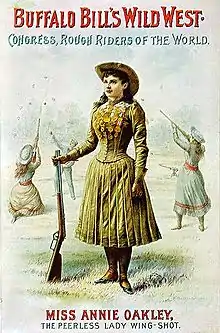 Approx. second half of 1880s poster showing Annie Oakley wearing short-skirted attire
Approx. second half of 1880s poster showing Annie Oakley wearing short-skirted attire 1896 ad showing a modified girdle, allowing women freedom of the lower extremities, making it easier to ride a bicycle, then in vogue
1896 ad showing a modified girdle, allowing women freedom of the lower extremities, making it easier to ride a bicycle, then in vogue An 1897 ad, showing a relatively early example of an ordinary non-sea-bathing woman in public view in unskirted garments (to ride a bicycle)
An 1897 ad, showing a relatively early example of an ordinary non-sea-bathing woman in public view in unskirted garments (to ride a bicycle)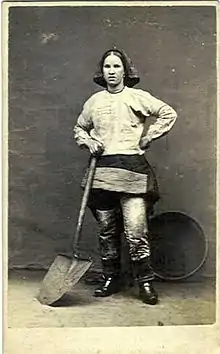 Wigan "pit brow lasses" scandalized by wearing trousers for dangerous work in coal mines. They wore skirts over their trousers, rolled up to the waist to keep them out of the way.
Wigan "pit brow lasses" scandalized by wearing trousers for dangerous work in coal mines. They wore skirts over their trousers, rolled up to the waist to keep them out of the way.
See also
References
- “Fashion, Emancipation, Reform and the Rational Undergarment” Deborah Jean Waugh ‘Dress’ Vol 4, 1978"
- Bryan, C.W. (1887). Good Housekeeping, Vols. 5-6.
- "Downtown Walk". Boston Women's Heritage Trail.
- Dress and Morality by Aileen Ribeiro, (Homes and Meier Publishers Inc: New York. 1986) p. 134
- "The Corset Controversy". www.jane-nickerson.com.
- "Woman's dress, a question of the day". Early Canadiana Online. Retrieved 26 March 2012.
- “Women's Clothes and Women's Right,” Robert E. Riegel, American Quarterly, 15 (1963): 390
- “Women's Clothes and Women's Right,” Robert E. Riegel, American Quarterly, 15 (1963): 391
- “Women's Clothes and Women's Right,” Robert E. Riegel, American Quarterly, 15 (1963): 400
- "Woman's dress, a question of the day". Early Canadiana Online. Retrieved 26 March 2012.
- Alice Bunker Stockham. Tokology 1898.
- Cunningham, Patricia A (2003). Reforming women's fashion, 1850-1920 : politics, health, and art. Kent, Ohio: Kent State University Press. Libris länk. ISBN 0873387422
- The New York Times, October 5, 1851: 'Bloomerism in London:...One journal hints very ill-naturedly that the new dress is best adapted for a particular class of "ladies", who, poor things, having a deal of "street-walking", would find the Bloomer costume quite a blessing..'
- The Times, Wednesday, Aug 20, 1851; pg. 5; Issue 20885; col A: ‘DEBUT OF THE “BLOOMER” COSTUME IN BELFAST:...Three ladies... made their appearance in full “Bloomer” costume...Others, and these most numerous, expressed an opinion the reverse of complimentary to the rank and character of the ladies, identifying them with persons whose overdressed gaiety of appearance in public stamps the class to which they belong.’
- The Times, Thursday, Aug 28, 1851; pg. 7; Issue 20892; col B: (A report from the Caledonian Mercury of two women appearing in Edinburgh in reformed dress)'BLOOMERISM IN EDINBURGH:...The singular spectacle thus presented attracted considerable attention even in the retired quarter of the town where it was witnessed, and comments, characterized by freedom more than politeness, were now and again made by urchins who followed the unblushing Bloomers...we learn that the ladies are Americans;...’
- "Women's Clothes and Women's Right", Robert E. Riegel, American Quarterly, 15 (1963):393
- Dress and Morality by Aileen Ribeiro, (Homes and Meier Publishers Inc: New York. 1986): 139
- The Visual History of Costume. Aileen Ribeiro and Valerie Cumming, (Costume & Fashion Press, New York, 1989):188
- Cunningham, Patricia A. (2003). Reforming women's fashion, 1850-1920: politics, health, and art. Kent, Ohio: Kent State University Press. ISBN 0873387422.
- Hazelius-Berg, Gunnel, Dräktreformer under 1800-talet, Fataburen Nordiska Museets och Skansens årsbok 1949 s. 127–156
- Bagerius, Henric.. Korsettkriget : modeslaveri och kvinnokamp vid förra sekelskiftet (Första utgåvan, första tryckningen). ISBN 978-91-27-15169-7. OCLC 1112090542
- “Women's Clothes and Women's Right,” Robert E. Riegel, American Quarterly, 15 (1963): 399
- “Women's Clothes and Women's Rights,” Robert E. Riegel, American Quarterly, 15 (1963): 400
- Dress and Morality by Aileen Ribeiro, (Homes and Meier Publishers Inc: New York. 1986) p. 143
- “Women's Clothes and Women's Rights,” Robert E. Riegel, American Quarterly, 15 (1963): 399
- (“Fashion, Emancipation, Reform and the Rational Undergarment” Deborah Jean Waugh ‘Dress’ Vol 4, 1978: 238 Quote by Lady Duff Gordon (Lucile) from “Discretions and Indiscretions”)